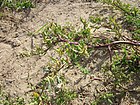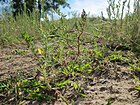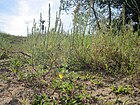Note: This is a project under development. The articles on this wiki are just being initiated and broadly incomplete. You can Help creating new pages.
Difference between revisions of "Chenopodium album"
(→References) |
(→References) |
||
| Line 70: | Line 70: | ||
<ref name="Leaf">[Morphology]</ref> | <ref name="Leaf">[Morphology]</ref> | ||
<ref name="How to plant/cultivate">[http://tropical.theferns.info/viewtropical.php?id=Chenopodium+album Cultivation]</ref> | <ref name="How to plant/cultivate">[http://tropical.theferns.info/viewtropical.php?id=Chenopodium+album Cultivation]</ref> | ||
| − | + | ||
</references> | </references> | ||
Revision as of 17:55, 14 April 2020
Chenopodium album is an erect, annual plant. It grows up to 150cm tall, though when growing in rich ground and in the longer daylengths in the temperate zone. it can sometimes reach up to 400cm. The plant is harvested from the wild for local use as a food and medicine.
Contents
- 1 Uses
- 2 Parts Used
- 3 Chemical Composition
- 4 Common names
- 5 Properties
- 6 Habit
- 7 Identification
- 8 List of Ayurvedic medicine in which the herb is used
- 9 Where to get the saplings
- 10 Mode of Propagation
- 11 How to plant/cultivate
- 12 Commonly seen growing in areas
- 13 Photo Gallery
- 14 References
- 15 External Links
Uses
Rheumatism, Bug bites, Sunstroke, Rheumatic joints, Swollen feet, Urinary problems, Sunburn, Bloody dysentery.
Parts Used
Chemical Composition
Common names
| Language | Common name |
|---|---|
| Kannada | |
| Hindi | |
| Malayalam | |
| Tamil | |
| Telugu | |
| Marathi | |
| Gujarathi | |
| Punjabi | |
| Kashmiri | |
| Sanskrit | |
| English |
Properties
Reference: Dravya - Substance, Rasa - Taste, Guna - Qualities, Veerya - Potency, Vipaka - Post-digesion effect, Karma - Pharmacological activity, Prabhava - Therepeutics.
Dravya
Rasa
Guna
Veerya
Vipaka
Karma
Prabhava
Habit
Identification
Leaf
| Kind | Shape | Feature |
|---|---|---|
Flower
| Type | Size | Color and composition | Stamen | More information |
|---|---|---|---|---|
| {{{5}}} |
Fruit
| Type | Size | Mass | Appearance | Seeds | More information |
|---|---|---|---|---|---|
Other features
List of Ayurvedic medicine in which the herb is used
Where to get the saplings
Mode of Propagation
How to plant/cultivate
Fat hen can be found in most regions of the world, from cold temperate to the tropics, where it normally grows at higher elevations.[3]
Commonly seen growing in areas
A common weed of cultivated ground, Especially on rich soils, Old manure heaps, Newly cultivated soils.
Photo Gallery
References
- ↑ [Chemistry]
- ↑ [Morphology]
- ↑ Cultivation
External Links
- [ ]
- [ ]
- [ ]
- Ayurvedic Herbs known to be helpful to treat Rheumatism
- Ayurvedic Herbs known to be helpful to treat Bug bites
- Ayurvedic Herbs known to be helpful to treat Sunstroke
- Ayurvedic Herbs known to be helpful to treat Rheumatic joints
- Ayurvedic Herbs known to be helpful to treat Swollen feet
- Ayurvedic Herbs known to be helpful to treat Urinary problems
- Ayurvedic Herbs known to be helpful to treat Sunburn
- Ayurvedic Herbs known to be helpful to treat Bloody dysentery
- Herbs with Seeds used in medicine
- Herbs with Leaves used in medicine
- Habit - Annual
- Index of Plants which can be propagated by Seeds
- Herbs that are commonly seen in the region of A common weed of cultivated ground
- Herbs that are commonly seen in the region of Especially on rich soils
- Herbs that are commonly seen in the region of Old manure heaps
- Herbs that are commonly seen in the region of Newly cultivated soils
- Herbs
- Pages without herbs images





